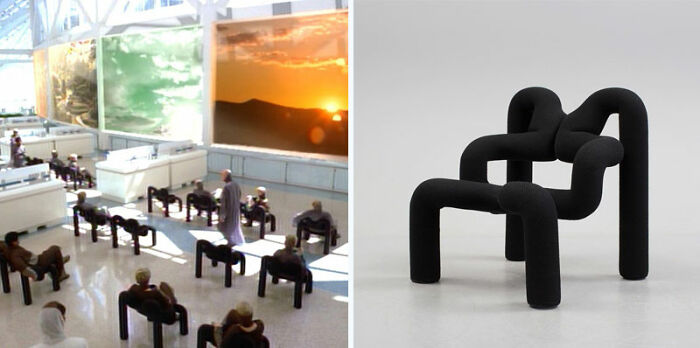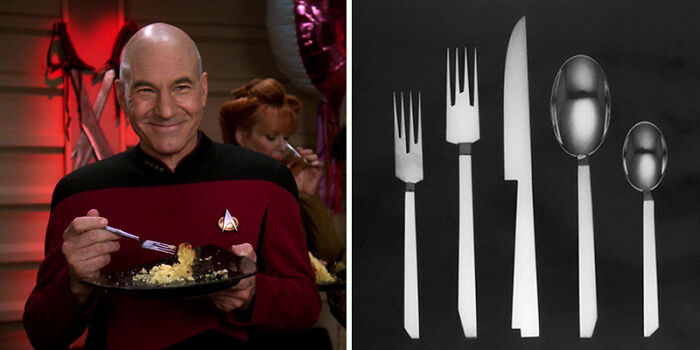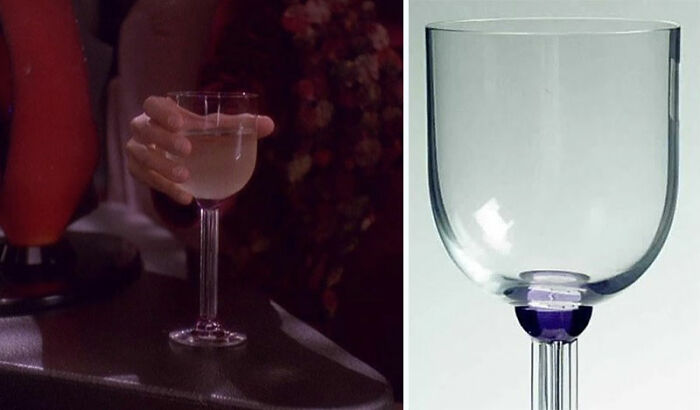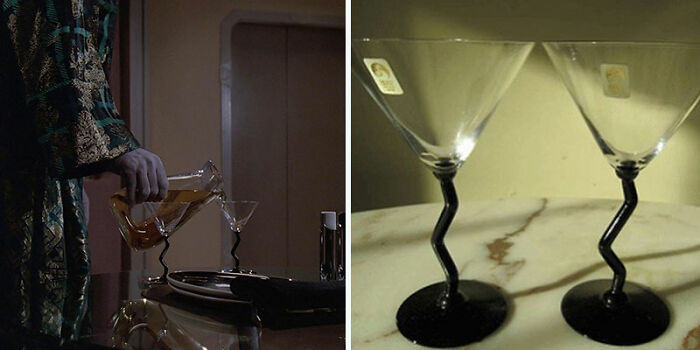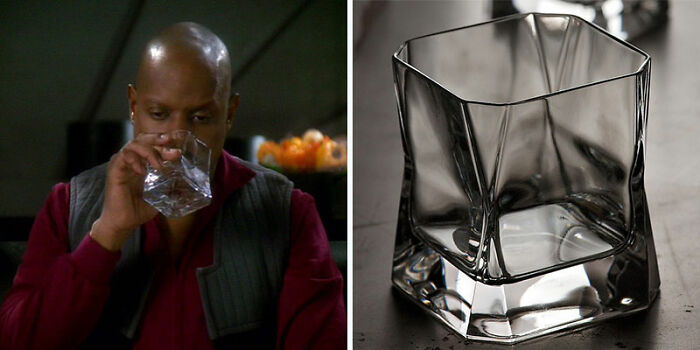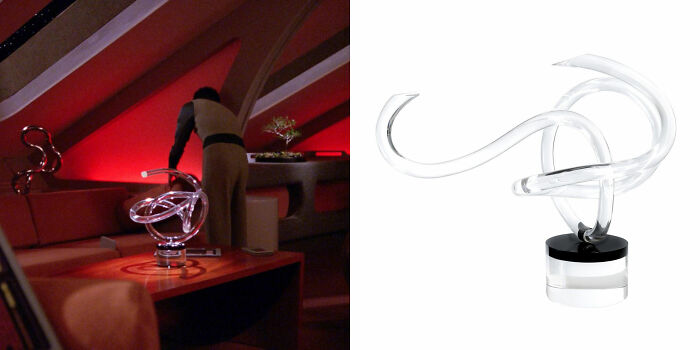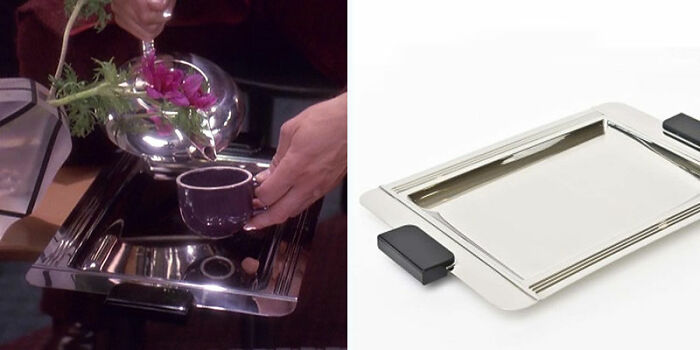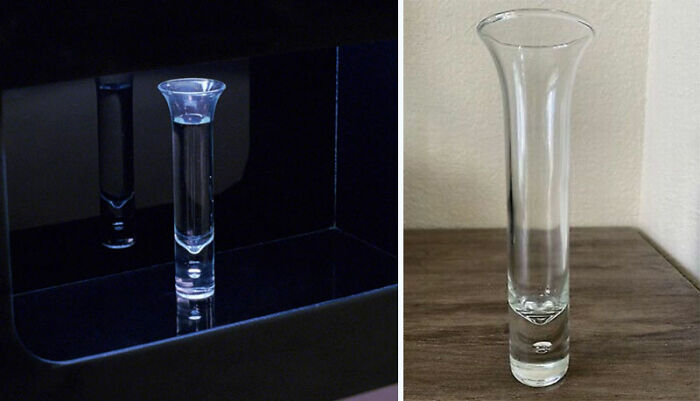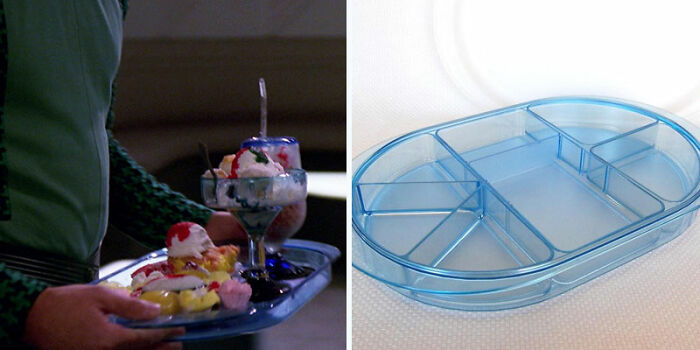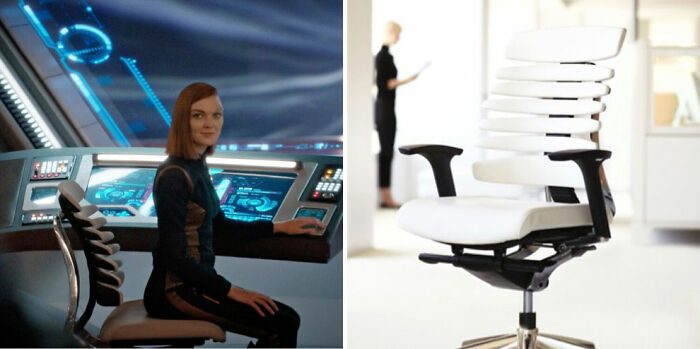
This Page On Instagram Collects Interior Design Objects Used In Star Trek, Here Are 30 Of The Best Finds
Interview With AuthorWhat if we told you that the set designers for Star Trek didn’t make every single thing that ever appeared on the show? Instead, the staff worked very carefully on sourcing and selecting everyday objects that would fit the overall theme of the show. Everything from cutlery to glasses and even chairs in the show were everyday items accessible to most of us (at some point). For example, Captain Janeway's office chair is a Signét 8400 chair from HÅG, which is a Norwegian design company, not to mention there were also items that were bought at IKEA.
With that being said, we’d like you to meet Eno, the owner of an Instagram page called ‘startrekdesign.’ Eno has carefully researched many of the objects, such as furniture and silverware, that appear in the Star Trek franchise, and decided to create an Instagram account to share his findings with other fans of the show!
More info: Instagram | star-trek.design
This post may include affiliate links.
Spherical Tube Lamps by Roger Rougier.
The Rougier Tube Lamp was the second ever piece I featured on Ex Astris Supellex. I initially claimed that it appeared in The Search for Spock and TNG, but have since discovered that the spherical version was also used in DS9, as set dressing on the Founder home world. They were designed and produced in the 1970’s.
It was in Next Gen, too (first?) I thought doneone got smart w/pvc piping
Someone DID get smart with pvc piping, it just wasn't a set designer on Star Trek.
Load More Replies...Similar designs were used in the Star Trek TNG - Angel One episode.
Bored Panda reached out to Eno.
“Well, when I started this project it was the beginning of quarantine. I had just gotten laid off from both my jobs because of the pandemic, so I was, like everyone else, stuck inside watching TV for hours a day. In my case, I was rewatching Star Trek pretty much all day every day."
Bistro Cup designed by Carsten Jorgensen for Bodum.
Carsten Jorgensen is a Danish industrial designer, best known for his work for Bodum. His Bistro teacup is so ubiquitous to The Next Generation, it is sometimes referred to as “The Picard Cup,” from which Captain Picard drinks his “Tea, Earl Grey, Hot.” It’s was also used in Voyager and the new Picard series. Originally designed in 1974, it is now out of production but is still relatively easy to find online.
It's quite common for tea to be served in glass cups. Look at Morocco and Turkey, for example.
Load More Replies...I’m still disappointed that Picard doesn’t drink his Earl Grey with milk and sugar, like any sane person would.
Adulterating Earl Grey with milk and sugar should be a crime.
Load More Replies...Ribbon Chair designed by Pierre Paulin for Artifort.
Another Paulin piece, this time appearing in The Original Series, in “The Cloud Minders.” Paulin’s chairs were used widely in TNG, but, to my knowledge, only appear this once in TOS. The Ribbon Chair, designed in 1966, was also used in Blade Runner 2049 (5th slide). It’s interesting to note, in both The Cloud Minders and Blade Runner 2049, these chairs appear to indicate wealth, status, and taste by the higher classes of caste-stratified societies. In contrast, the use of Paulin’s furnishings in TNG do the opposite: they offer a scene of the comfort and aesthetics attainable and accessible to all Federation citizens in a society based on cooperation and equality.
"I'd already known about a few designers whose work was used: Carsten Jorgensen (the 'Picard Cup'), Maurice Burke (the Tulip Chair from TOS), and Joe Colombo (the Boby Cart used in almost every sick bay). I was always really delighted to see furniture and objects I recognized on screen and I was curious about what else had been used. I started an Instagram as a kind of personal project to document what I learned. It turned out other people liked it, and it's grown pretty exponentially."
Tatlin Sofa designed by Marion Cananzi & Roberto Semprini for Edra.
The Tatlin Sofa was designed in the late 1980’s for Italian design firm, Edra. It’s name and distinctive spiral shape are referential to Tatlin’s Tower (sixth slide), the unbuilt monument to the 3rd International designed by the Russian artist, Vladimir Tatlin, following the Bolshevik Revolution. It seems ironic to be used to furnish the collection room of a private collector/hoarder of stolen artwork (and kidnapper of Data) in the TNG episode “The Most Toys.”
Sylvie Chair by R & Y Augousti.
R & Y Augousti is a French furniture company, known for maximalism and use of organic shapes. The Sylvie chair, designed sometime in the 1990’s, was used in the TNG episode, “Eye of the Beholder.”
"Pretty soon after beginning, I found the websites Quark’s Qantina and Ex Astris Scientia, which each maintain pages sourcing the tableware and chairs, respectively, used across Star Trek series. I shouldn't have been surprised I was not alone in this hobby. Some of the posts on my Instagram and website are originally from them (always credited). Now that I've learned a lot more about design history and styles, I've been increasingly able to source objects on my own. I actually collaborate with both Quark's Qantina and EAS now, which is kind of a dream since I admire them so much.”
Cocktail Shaker designed by Sylvia Stave.
Sylvia Stave was a Swedish designer, best known for her work in pewter, brass, and silver. This cocktail shaker was originally designed in 1937, and then reproduced in 1989 for Italian housewares company, Alessi. It was used in Star Trek TNG.
Oh, so Data was getting a cocktail to go? And we were made to believe it was coffee or tea... tze !
There's a scene where Picard is using Aldo Rossi's Alessi il Conico kettle. It can be seen in several different scenes too. alessi2-80...6d517f.jpg 
Hill House Chair designed by Charles Rennie Mackintosh.
Charles Rennie Mackintosh was a Scottish architect and designer, whose Argyle Chair I’ve previously featured. His Hill House Chair was designed in 1902 as a furnishing accessory for the Hill House in Helensburgh, Scotland. Like the Argyle Chair, the Hill House Chair was used in the Enterprise episode, “Exile.” It was also used, more prominently and more often, in Babylon 5, as the seating for the council chamber.
If you read the entry, it says they were used in an episode of Enterprise AND ALSO, more prominently, in Babylon 5.
Load More Replies...Mackintosh's other design, the Argyle is also used in Star Trek. mcknts-625...eb70ea.jpg 
It was used in the Enterprise for sure. Mackintosh's other design, the Argyle chair was used in the Star Trek TNG. mckntsh2-8...5a6497.jpg 
I stayed in a hotel that had some of these. They have a design flaw. If you stood up too fast, they would flip over backwards because they were so top heavy.
Of course, there were more things we wanted to ask Eno! So first, we wanted to know about the most challenging parts when it came to finding interior pieces featured in Star Trek.
"That’d probably be finding some of the objects that were used in The Original Series. In general, it’s easier to find better-known designer pieces, which Star Trek certainly did use fairly often, but the production designers also used furniture from department stores and props warehouses. So it’s difficult to find these pieces from the 1960s, from furniture companies that no longer exist and weren’t well-known enough to have anything written about them. On top of that, a lot of the furniture, tableware, etc. was altered by set designers to make them look more futuristic or cohesive with the aesthetics of the show. TOS pieces probably account for the majority of my 'Unidentified' folder."
Serpentine Sofa designed by Milo Baughman.
Baughman was a mid century furniture designer, whose serpentine sofa was produced in the 1970’s. If this is his design (which, based on all of the serpentine sofa’s I’ve found, and that TNG has used Baughman’s designs in the past, I believe it is), it was used in TNG to furnish Deanna Troi’s office.
The 2 sofas pictured might be by the same designer but they most certainly not the same sofa.
Exemplary Choice by set designers for a therapy office. And I always thought that the lighting and choice of colors were spot on, as well.
Exemplary choice by set designers for a psychotherapist’s office. I admired the soothing lighting and choice of colors, as well.
Why DOES Deanna Troy have such a massive sofa in her office? Does her client list include any spice worms from Arakkis?
Pyramid Wine Glasses by Cristal d'Arques.
Cristal d'Arques is a French crystalware manufacturer, founded in 1968. The Pyramid set is no longer in production, but can still be found on Etsy and EBay. They were used in Star Trek Voyager, in the episode “Body and Soul.”
We figured that finding all of the sources wasn't an easy job, so we wanted to know how long it usually takes to search for them.
"That’s dependent upon the object. Some have already been identified by other Trekkies or collectors (who I always credit in my posts), and some I just recognize from life or can find fairly easily because I’ve become more familiar with different styles and periods. Then there are some objects, like the Paul Boulva chairs used most famously in Ten Forward, that took over a year to find. For those, I spent so much time emailing furniture designers selling similar (or the same) chairs, but almost no one seemed to know who made them. One seller offered that they knew they were made in Canada, so I started reading everything I could about Canadian postmodern furniture designers and manufacturers. Eventually, I found Paul Boulva’s website, which is literally just a YouTube video. It became pretty clear why people had so much trouble finding these despite how incredibly iconic they are since there are no searchable terms on his website."
Teacup designed by George Sowden for Bodum.
George Sowden is an English industrial designer and one of the founders of the Memphis Group. These teacups were designed in 1987 for Bodum, and were used in the TNG episode, “Pen Pals.”
I actually saw some that were at least similar to these in a charity shop, but.. I'm not really a watcher of star trek so I wouldn't have recognized them anyway. xP
Ekstrem Chair designed by Terje Ekstrøm for Stokke.
Terje Ekstrøm was a Norwegian industrial designer and pioneer of Norwegian postmodernism. His Ekstrem chair was designed in 1972 and manufactured in the 1980’s by Stokke. It was used in Star Trek Voyager on the Ocampa home world.
I've tried it and it's actually very comfortable and allows different ways to sit. It's problem is that it's very bulky and fits poorly with basically with anything else you have in the house.
Load More Replies...It could give you roids because it’s like sitting on a toilet. Fine for a while but not for too long!
Demotivation is something most of us have dealt with, but when it comes to searching for hidden gems, that is certainly not the case for Eno.
"No, quite the opposite! I get frustrated sometimes when I’ve been searching for something for a long time and can’t find it, but that just makes me more motivated. The biggest example is this 1980s tubular steel dining set that was used in several crew quarters in TNG, and it’s honestly become my white whale. I’ve emailed some dealers who I’ve seen selling it and periodically I make Instagram stories asking if anyone knows anything, and I’ve gotten some good leads but no attributions. What I know so far is that it's Canadian and it’s definitely not Amisco."
We also wanted to find out how people reacted to the work Eno does for the fandom.
"Always positively! I’m honestly startled by how many people appreciate Star Trek + Design, since it’s so niche. The closest I’ve gotten to a 'negative' reaction is someone correcting me when I made a misattribution, which I actually really appreciate because I’d like everything I post to be accurate."
Exl Flatware designed by Robert Wilhite for Bissell & Wilhite.
Robert Wilhite is an American artist and industrial designer whose work explores geometric abstraction. This is apparent in his flatware designs. The Exl pattern features sharp, asymmetric shapes and angles that appear simultaneously severe and playful. This flatware set was used in seasons 6 and 7 of Star Trek: The Next Generation.
Suspens and Suspension Chairs designed by Paul Boulva for Artopex.
Paul Boulva is a Canadian furniture designer, best known to design aficionados as the designer of the Artopex Lotus chairs. Very few, however, know about his far-more famous chair designs (though I imagine this will become public knowledge very soon): the Suspens and Suspension chairs, designed in the 1980s. The Suspens chairs were used as seating for Ten Forward in TNG, while the Suspension chairs were used in both Ten Forward and in Voyager’s Mess Hall. These are sometimes misattributed to Jan Ekselius, who designed very similar chairs.
I'm looking at the tall one on the right and all I can image is Riker trying to pull a Riker Straddle on it 😂
Finding all of these pieces must be a fun hobby on its own, but we wanted to know what was the most enjoyable part of the process.
"Learning about design history, for sure. When I started the project, I didn’t actually know much about it. I still don’t have the knowledge of someone with, say, classical education in design, but I love learning. I have some great followers who have taught me so much about Italian Modernism and Space Age and others. I was, and am, a Trekkie, but learning about industrial design history has been enriching for my own life and increased my appreciation for Star Trek, which I didn’t think was possible.
Another thing that’s really exciting for me is that I’ve started collaborating with Ex Astris Scientia on identifying the commercially available chairs and lighting used in Trek, and with Quark’s Qantina on glassware and tableware, which is really rewarding because I admire them and their work so much."
E1027 Table designed by Eileen Gray.
Eileen Gray was an Irish architect, furniture designer, and pioneer of early modernism. Her E1027 Table, designed in 1927, is adjustable and was designed for use “over the knees” or as an occasional/side table. It was used in The Search for Spock, in the Starfleet Officer’s Lounge.
Turner Chair designed by Jack Crebolder for Harvink.
Jack Crebolder was a Dutch industrial designer, whose Turner Chair was designed in 1982. It was meant to be limited addition, and only 1000 original chairs were ever manufactured. The Turner Chair was used in a single episode of The Next Generation, “Haven.”
As for the last question, we wanted to ask Eno what inspired him to start his Instagram page.
"I was already aware of (and owned) some of the objects used in Trek and thought it’d be a fun quarantine project to learn more about the other pieces that were used. I started an Instagram because I like the interactive nature of the platform and thought I could collaborate with people who might know more about design than me, and that’s exactly what happened. At this point, it’s become a rabbit hole. I have a folder on my computer with over 3,000 Star Trek screencaps of both identified and unidentified objects. It’s funny, when I started Star Trek + Design, I was worried I’d eventually hit a wall and run out of objects to make posts about, but I don’t think that’s going to be a problem any longer."
Boby Cart designed by Joe Colombo.
Joe Colombo was an influential midcentury Italian industrial designer whose Boby Cart is essential to Star Trek medical design. They were used in The Final Frontier as a bridge prop, TNG Enterprise and alien Sick Bays, and DS9 Sick Bay. If anyone has a screenshot of it used on Voyager or Enterprise, please let me know. I haven’t noticed one, but I wouldn’t be surprised if it was used.
I always wanted one of those - but now my camera gear is just too big and heavy. And I don't do small stuff anymore. Might just buy one for the hell of it.
Chicago Amethyst Water Goblet by Sasaki.
Sasaki was a Japanese glassware manufacturer. Their Chicago water goblets were used in the DS9 episode, “Looking for par’Mach in All the Wrong Places,” as glassware for Keiko and O’Brien’s quarters. The Chicago line is no longer in production.
No Spill Mugs by Feltman-Langer.
Feltman-Langer, now known as AmericaWare, is an American souvenir supply company. While the company’s specialty is adventure and vacation themed cups and accessories, they are best known for their contribution to Deep Space Nine. These mugs were painted light blue, likely by set designers, to serve as the Replimat’s Raktajino mugs. Designed in the 1980’s, they are no longer in production. They’re very easy to find online, but not in the classic Replimat Blue.
Had one of these (blue), but didn't know they were called "No Spill" - this is ludicrous, because if you want to drink the last sip from such a mug your almost guaranteed to spill it all over you as you have to put your head far back and turn the mug almost upside down.
I had one with a rubberized mat on the bottom - a lot of people used to have them on their dashboards to drink out of while driving (hopefully while at a stoplight, but...welp). I think "no spill" in this case meant that they wouldn't slide off the dash. Totally agree with you on the last sip, tho. I think I would use a straw.
Load More Replies...I'd like to believe that "sailing" on DSN should be smooth enough not to necessitate mugs designed for rough seas.
Tea Set designed by Yoshiharu Fuwa for Cook Vessel.
Yoshiharu Fuwa was a Japanese industrial designer. This aluminum tea set for Cook Vessel is one of his most recognizable works, and continues to be sought after by admirers of postmodern and Memphis-style design. It was used in The Next Generation episode, “The Drumhead,” as the tea service in Admiral Norah Satie’s quarters.
Gakko Slide Chair designed by Tayfur Ozkaynak for Soho Concept.
Tayfur Ozkaynak is a contemporary industrial designer, who’s designed several chairs for Soho Concept. The Gakko Slide chair was used as seating for Discovery’s mess hall.
KN1001 Side Table by Keiser-Newman.
Keiser-Newman was a American furniture manufacturer, founded in 1982, by Bruce Keiser and Don Newman. This side table, constructed from glass, aluminum, and Carrera marble, is evocative of a flying saucer. It remains Keiser-Newman’s most recognizable work. In what might be a Mandela effect of design history, this side table is more often found online as “Kaiser Newman,” and is often dated as having been produced in the 1990′s, despite first appearing in Star Trek in 1989. It was used in The Next Generation as set dressing for Riker’s quarters.
I like their look alot, but any table that has legs sticking out from under it will end up a serious tripping hazard (at least for me!).
Agreed. Maybe you would need to turn it 180 degrees to avoid the tripping hazard.
Load More Replies...Kinetic Ribbon Sculpture by C. Jeré.
C. Jeré is an American metalworking company and producer of decorative sculptures and wall hangings. The Star Trek set designers must have really loved this company, as this is the third C. Jeré piece I’ve posted so far. It was used in TNG as set dressing for Data’s Quarters.
Vacuum Pitcher by Thermos.
This is a very minor piece that, to my knowledge, only appeared in one episode of Star Trek (well, two if we’re counting The Cage and The Menagerie separately), but it’s meaningful for me because it’s the first ever item I added to my “Unidentified” folder and I’m happy to finally remove it.
Very different from others here because it wasn't about style, but substance: Thermos vacuum pitchers were once very high-tech. Of course, they'd be 100s of years old by the era of Star Trek and you only could recognize them by their style...
Rocking Chaise designed by Milo Baughman for Thayer Coggin.
Milo Baughman was a prolific American furniture designer, best know for his work for Thayer Coggin. His iconic rocking chaises were designed and produced in the 1970’s and are fairly easy to find online. Unfortunately, the rounded versions, which were used in Star Trek, are much rarer than the squared ones. They were used to furnish the Enterprise-D’s crew quarters in The Next Generation.
Oktett Champagne Flutes by Bodum.
Bodum products were used often by Star Trek TNG set designers, the most famous example being Carsten Jorgensen’s Bistro “Picard Cup.” The Oktett champagne flutes were used most prominently in the episode “Haven,” but also appear in background of several shots throughout the series. I believe the flatware pictured is also Bodum.
it's 1st season because natasha is still there. first time ever i couldn't believe they actually killed of a character :'(
Load More Replies...HotJo Travel Mug by Highwave.
The HotJo mugs were used in several episodes of DS9, as Quark’s Bar’s Raktajino cups. While these mugs are still being produced by Highwave, the purple version was commissioned specifically for Star Trek, and is not commercially available.
Von Vogelsang Chairs designed by Philippe Starck for Driade.
Philippe Starck is a French architect and industrial designer, who also designed the Romantica Chairs used in TNG and Enterprise. The Von Vogelsang chairs were designed in 1985 and used in The Next Generation episode, “Sarek.”
They look very uncomfortable. I'd expect no leg circulation after only a few minutes.
Landscape Dining Set designed by Ross Lovegrove for Frighetto.
Ross Lovegrove is a Welsh industrial designer known for his use of sinuous, organic shapes. The Landscape dining table and chairs were originally designed in 1998 for Frighetto, though the tables are no longer in production. The chairs are now manufactured by Italian furniture company, Estel. Both were used in ENT, as furnishing for the Enterprise NX-01’s mess hall.
This looks very uncomfortable. But maybe we need a separate article interviewing the actors on their opinions about these props?
Bored Panda ripped these off from Instagram. This isn't really their article in the first place. They're certainly not going to bother interview actors as the people who put these lists together aren't journalists. The site is clickbait for advertising sales.
Load More Replies...Jamaica Stool designed by Pepe Cortes for Knoll.
Pepe Cortes is a Spanish industrial and interior designer, and founder of the Grupo Abierto de Diseño, a Barcelona-based design group. His Jamaica Stool, designed in 1991, remains his most recognizable work. It was used in Star Trek: First Contact, as furnishing for the Zephram Cochrane’s favorite bar, and in Voyager, in Harry Kim’s San Francisco apartment and Dr. Louis Zimmerman’s lab.
Jamestown Tumbler by Fostoria.
Fostoria was an American glassware company, which reached its peak of popularity in the 1950’s. The Jamestown pattern was produced in a variety of colors. The smoky brown tumblers were used in The Original Series episode, “The Conscience of the King.”
The one episode where Shatner us actually out-hammed by other actors.
I'm going to have to watch that one now. The idea that Shatner gets out-hammed is intriguing.
Load More Replies...Zigzag Stem Martini Glasses by Sasaki.
This is a correction of an earlier post! I initially attributed these glasses to Fris Vodka, which produced very similar martini glasses with black zigzag stems. I was recently informed by Barb, of Quark’s Qantina, that the actual glasses used were produced by Sasaki. I’ve been unsuccessful in finding any more images online, but Barb sent me the one used in the final slide, from her own glassware collection, with the Sasaki label still attached.
Groovy Lounge Chair designed by Pierre Paulin for Artifort.
Yet another Paulin post! These chairs were for designed for Dutch design group, Artifort, in 1973. The Groovy Chair outfits the corridors and crew quarters of the Enterprise-D in Star Trek: The Next Generation.
Paperclip Stool designed by Hugh Hamilton & Philip Salmon for Kinetics.
Kinetics was a mid century and postmodern furniture company, best known as the original manufacturers of the K700 Paperclip Stool in 1969. It was used as set dressing for the Romulan ship in the TNG episode, “Timescape.”
LC2 Sofa and Armchairs designed by Le Corbusier, Charlotte Perriand, and Pierre Jeanneret.
This sofa and armchair set is one of the first collaborations that Charlotte Perriand (whose Revolving Armchair was previously featured) had with Le Corbusier’s studio. Designed in 1928, it would famously be featured in Paris’s 1929 Salon d’Automne. This set was used in just one episode of Star Trek: in Harry Kim’s San Francisco apartment in the Voyager episode “Non Sequitur.” I look forward to a future where even forever-ensigns have access to apartments with skyline views and Le Corbusier furniture.
I picture a couple of A. M. Cassandre Jazz Age lost gens languidly lounging in Le Corbusier
Swan Candlesticks designed by Matthew Hilton for SPC.
Matthew Hilton is an English industrial designer. His Swan candlesticks were designed in the 1980’s. They were used in a few Deep Space Nine episodes, and in the Voyager episode, “Parturition.”
Aluminum Measuring Cup by Thunder Group.
Thunder Group is a restaurant supply company, founded in Taiwan in 1956. These aluminum measuring cups were used as the iconic Klingon Bloodwine goblets, in scenes where the set-designer-created Bloodwine Cups were not used. They were used in Star Trek DS9 and Voyager, and are still in production.
Cibi Whiskey Glass designed by Cini Boeri for Arnolfo di Cambio.
Cini Boeri was a mid century Italian architect and industrial designer, and one of the first internationally renowned female architects from Italy. Her Cibi glass, for luxury crystalware company, Arnolfo di Cambio, was designed in 1973. While best known for its appearance as Decker’s whiskey glass in Blade Runner, it was also featured in Deep Space Nine, as Sisko’s whiskey glass during his monologue scenes in “In the Pale Moonlight.”
Platner Stool designed by Warren Platner for Knoll.
Warren Platner was a mid century American architect and interior designer, whose Platner collection was designed in 1966, for Knoll. His stools were used in The Next Generation, as set dressing for Counselor Troi’s office.
There is also a Tulip Chair, and Eames side table, and an Eames-ish coffee table in that room.
Cantilever 290 Chair designed by Steen Ostergaard for Cado.
Steen Ostergaard is a Danish industrial designer, best known for his elegant, space age furniture designs. His 290 Chairs, designed in 1966, were the first ever cantilevered chairs to be injection molded in a single operation. The were used in Star Trek: The Search for Spock, as furnishing for the observation lounge at Earth Spacedock.
Romantica Chair designed by Philippe Starck for Driade.
Philippe Starck is a prolific French architect, vehicular designer, and industrial designer. His curved aluminum Romantica chair was designed for Italian furniture firm, Driade, in 1988. It was used in both Star Trek TNG and Enterprise, each time in alien settings.
La Cupola Espresso Maker designed by Aldo Rossi for Alessi.
Aldo Rossi was an Italian architect and designer, and one of the leading proponents of postmodernism. His La Cupola espresso maker was designed in 1988 for luxury Italian houseware company, Alessi. It was used in both Star Trek Voyager and Enterprise.
Pajala Bistro Set by IKEA.
It’s been my impression that the set designers for The Original Series, The Next Generation, and Voyager typically avoided using IKEA products, possibly because they would be too recognizable to viewers. Deep Space Nine broke this convention, instead opting to use IKEA products often and prominently. I’ve previously made posts featuring the Anima Chairs used in Quark’s Bar and the IKE1 Flatware used in certain crew quarters. The Pajala Bistro set was used for the scenes in Sisko’s Creole Kitchen. If you look closely, you’ll notice the conical candle holders on each of the tables. Those are Skovbo candle holders, also from IKEA.
That’s a clever move: ikea stuff gets thrown out super quick; most of their designs are soon forgotten - and then coming generations won’t be snobbish about a set design, just because they used to have the same.
Swivel Lounge Chair designed by Milo Baughman for Thayer Coggin.
Milo Baughman was an American furniture designer, best known for his designs for Thayer Coggin. Several of his designs were used in Star Trek TNG. This Swivel Lounge Chair, produced in the 1970s, was used to furnish Kirk’s apartment in The Wrath of Khan.
Tulip Chair by Maurice Burke for Arkana.
I featured Maurice Burke’s Tulip Chair as my first ever post on this Instagram. Obviously, due to low engagement at the time, it got very few likes. Burke’s Tulip Chair is arguably the most quintessential chair of Star Trek and I wanted to make another post for it, with better views. Maurice Burke was an American mid century furniture designer whose work was used (and altered) for multiple props in Star Trek TOS. This post features both the Model 115 and Model 116 (the armchair), both designed by Burke and both used in Star Trek.
Bibendum Lounge Chair designed by Eileen Gray for Classicon.
Eileen Gray was an Irish furniture designer and architect, and pioneer of early modernism. Her Bibendum chair, designed in 1929, was used in Star Trek TNG, to furnish certain crew quarters.
Elda Chair designed by Joe Colombo.
Joe Colombo was a prolific mid century furniture and lighting designer, best known for his bright Space Age designs. His Elda chair was designed in 1964 and manufactured by Comfort Italy. I’ve already published a post about the Elda chair’s use in Star Trek TOS, but it was also featured, more prominently, in Space 1999.
It looks very intestinal, uh interesting sorry. Or intestinalresting?
Load More Replies...Tubular Stools by Amisco.
Amisco is a Canadian furniture manufacturer, best known to design aficionados for their postmodern chairs from the 1980’s. These tubular bar stools are of that era. They were used in TNG, and are pictured here in the episode, “When the Bough Breaks.”
MR Cantilever Chair designed by Mies van der Rohe.
Mies van der Rohe was an eminent architect, pioneer of modernism, and the last director of the Bauhaus school. His MR Cantilever chair was designed in 1927 for the Weissenholf development project in Stuttgart, Germany. It was used in Star Trek Voyager to furnish the office of Henry Starling in the episode “Future’s End.”
Theory Glasses by Circleware Crystal.
Circleware is a manufacturer and distributor of glassware. Aside from the name, I couldn’t find much info about the glasses or the company. They are still in production and can be easily found online. Drinking glasses from the Theory set were used in Deep Space Nine and Voyager.
Sugar Bowl designed by Carsten Jörgensen for Bodum.
Carsten Jörgensen is a Swiss industrial designer, best known for his work for Bodum (including the famous “Picard cup”). This sugar bowl was used as a drinking glass in Star Trek Voyager.
Octime Clear Glass by Arcoroc.
If you’ve been following this page long enough, you know I’m obsessed with these octagonal Arcoroc glasses. I’ve made posts about their use in TNG and Lower Decks, but they were also used, less prominently, in Battlestar Galactica.
Swivel Chair designed by Arthur Umanoff for Madison Industries.
Arthur Umanoff was a mid century American furniture designer who’s work was heavily inspired by Danish Modernism. This swivel chair, designed in the 1960’s, was used in The Original Series Pilot, “The Cage.” This is the second Arthur Umanoff piece I’ve featured, the first being a lounge chair which served as the base for the Enterprise’s Captain’s Chair in TOS.
Atomic Galaxy by C. Jeré.
Also known a Curtis Jeré, C. Jeré is an American metalworking company, specializing in decorative sculptures and wall hangings. This Atomic Galaxy is the second C. Jeré piece with this name, the first being designed in 1965. This version was produced in 1982, and was used in Star Trek TNG to decorate certain crew quarters. This is now the fourth work by C. Jeré that I’ve featured.
Forever 11 Sculpture by Hivo Van Teal.
Van Teal was a Cuban-American sculptor and lighting designer who gained popularity in the 1970s, when he was selling his sculptures in American department stores as financially and aesthetically accessible art for the middle class. His fame is partially derived from his “American Dream” story of being a Cuban immigrant whose bourgeois family opposed the Cuban revolution and emigrated to the US, where he held working class jobs until became established as a successful artist and lighting designer. One can’t help but wonder how Van Teal may have felt about his work being used in Star Trek: The Next Generation, a tv show about a post-capitalist multicultural spacefaring society.
Not to be mistaken for the Forever 21 sculpture. It's okay. I'll show myself out.
AJ Flatware designed by Arne Jacobsen.
Arne Jacobsen was a Danish mid century architect and industrial designer, best known for his sleek space age chairs. His AJ flatware was designed in 1957. I’ve previously made posts about the set’s use in Star Trek Voyager and Enterprise, but it was used more famously, if less prominently, in Stanley Kubrick’s 2001: A Space Odyssey.
Shogun Tavolo Lamp designed by Mario Botta for Artemide.
Mario Botta is a Swiss architect and industrial designer, most closely associated with postmodernism. His Shogun Tavolo lamp was designed in 1986 for Artemide, and is a part of the permanent collection of the Metropolitan Museum of Art in NYC. It was used in the Star Trek TNG episode, “A Matter of Perspective,” as set dressing for one of the bedrooms on the Tanuga IV research station.
Amethyst Champagne Flutes by Colony.
Colony was a mid century American glassware manufacturer, whose Amethyst series is spuriously dated on auction and second-hand sites; it could be assumed, given the mid century attribution, that they were produced sometime between the 1950s and 1970s. They’re remarkable for their textured (in the case of DS9, spiraled) stems. They were used in Deep Space 9, most prominently in this dinner scene with Captain Sisko and Kasidy Yates.
IKE1 Flatware by IKEA.
I’ve had these screenshots saved in my unidentified folder for months, and was finally able to source them yesterday when I saw them on @330modern’s instagram. I don’t know much about this set, but I’d guess they were probably in production sometime in the late 80’s or early 90’s. The were used in Deep Space 9.
We still have these, use them daily. Saw them on the Klingon Homeworld. Pretty sure we bought them in IKEA around year 2000.
Fledermaus Chair designed by Josef Hoffman.
Josef Hoffman was an Austrian architect and designer, and pioneer of early modernism. He was a founder of the Vienna Secession (a design movement linked to Art Nouveau) and the Vienna Workshop (an early modern design group). The Fledermaus Chair was designed in 1907 for the Vienna Cabaret and has since undergone several design revisions. The Fledermaus Chair was used in season 7 of TNG, to furnish the poker scenes in Riker’s quarters.
They are not comfortable to sit in for any length of time. Chairs like this - that are angled just enough to be uncomfortable after half an hour or so - are used in cafes and coffee shops all over the world to encourage customers to move on and turn over tables. Cafes don't make money if someone nurses a coffee, taking up space for hours at a time.
They really don't look comfortable, either. And especially not for tall people, as were sitting on them in that scene
Load More Replies...Greco Serving Tray by Couzon.
Couzon was a French tableware manufacturer, founded as Jean Couzon in 1934. Their Greco serving tray, inspired by Art Deco, was produced in the 1980’s. It was used in the DS9 episode, “Rejoined.”
Boby Cart designed by Joe Colombo.
My previous post inspired my to make a second post for Colombo’s Boby Cart, now that I’ve found more screenshots of it used in Star Trek. Almost always in the background of shots, the Boby Cart is both futuristic and utilitarian, which makes it ideal for Sick Bay and alien hospital scenes.
Glass and Lucite Coffee Table designed by Charles Hollis Jones.
Charles Hollis Jones is an American furniture designer, most famous for his work in glass and lucite. These coffee tables, which appear in several crew quarters in The Next Generation, feature distinctive lucite and chrome bases. The glass surfaces are detachable, and we see that set designers added a square top to the one appearing in the Enterprise-D’s corridor, next to the Paulin chairs. They were manufactured in the 1970s.
Neptune Champagne Flutes by Luminarc.
Luminarc is a French glassware company, founded as Verrerie des Sept Ecluses in 1825. While the company still exists, it has changed ownership and names multiple times and is currently known as Arc International. I use the name Luminarc because that was the name of the company when the Neptune collection was produced, sometime before 1992 (I’d guess the 1980’s or very early 90’s). It was used in at least one episode of The Next Generation, the one I know of being “Datalore.”
Luminarc is in every supermarket in France, Arc is just the company name. Like Sprite who is owned by The Cocacola company, the brand name is still Sprite.
Bud Vase by Riekes-Crisa.
Riekes-Crisa was a glassware company, specializing in home goods. These bud vases, which I’ve been unable to date, were manufactured in Australia. They were used in several episodes Star Trek TNG as drinking glasses. Star Trek set designers have an amusing history of repurposing objects as futuristic-looking drinking glasses, such as the Carsten Jörgensen sugar bowls that I’ve previously featured.
Blue Acrylic Serving Dish by Tupperware.
This is one of those objects where I’ve had one screenshot I’ve been holding onto in the hopes of finding more screenshots, to no avail. This serving dish, used in a single scene in Ten Forward, was manufactured by the Tupperware corporation and features detachable dividers.
RBT Teknion Chair.
Toledo Chair designed by Jorge Pensi for Knoll.
Jorge Pensi is an Argentinian-born Spanish industrial designer whose Toledo chair was designed in 1988 for Knoll. It was used in Star Trek Voyager and Enterprise.
Landi Chair designed by Hans Coray for P. And W. Blattmann Metallwarenfabrik.
Hans Coray was a Swiss artist and industrial designer. The Landi Chair, designed in 1938, remains his best known design. It’s historically significant as one of the first successful chair designs using the then-new material of sheet aluminum. The Landi Chair is now part of the permanent collections of the Museum of Modern Art and the Cooper Hewitt in NYC. It was used in Star Trek: First Contact in the bar scenes with Zephram Cochrane.
Balans Aktiv Chair designed by Svein Gusrud for HÅG.
Svein Gusrud is a Norwegian furniture designer and professor at the Oslo National Academy of the Arts. His Balans Aktiv kneeling chair was designed in 1979 and was used to furnish Regula I station in The Wrath of Khan.
Anova Chair designed by Peter Opsvik for Håg.
Peter Opsvik is a Norwegian industrial designer, best known for his unique, ergonomic chairs. His Anova chairs were designed in 1978 for Norwegian furniture manufacturer, Håg. They were used in The Next Generation as seating for the Enterprise-D’s observation lounge.
There are also Iittala glassware on ST Enterprise series. Ultima Thule, Tapio and Stella glasses are featured if I remember correctly.
I always remember the walkie-talkie things they use in one of the Star Wars were Gillette Sensor women’s razor handles spray painted silver!
Was I the only one confused when the image chosen for the thumbnail on the front page was taken from "Babylon 5"?
In Star Trek Enterprise S04E03 «Home» (October 2004) a woven aluminum basket can be seen in the house of T’Les, on Vulcan. This kind of baskets were rather popular in the early 2000’s and could be found in most homeware stores. Panier-en-...fe-png.jpg 
If you think you're a real geek, I'll ask you: are you geek enough to store screenshots of tableware, glasses and furniture in SciFi-shows/movies in hopes of finding them somewhere in real life?? That said - man, "Enterprise" was a really good show and I've soo many fond memories of TNG, DS9 and Babylon 5. I really must take time to watch some of them again.
Some of the clothing should have been featured here too. I use to have a shirt worn by the Kera character. It was a white shirt with a woven part on top. I got rid of it in the past since it had an ugly blood stain on it. I didn't know how to get rid of it at the time but soon after I did. But now its too late. I has regrets. ☹️😔 Its this one. https://www.google.com/search?q=kira+nerys+white+top&client=firefox-b-d&tbm=isch&source=iu&ictx=1&fir=ayQC0ER0-TrVuM%252CXNQreZ4nCW_h5M%252C_&vet=1&usg=AI4_-kR-8x536M3FrbwOfT7l7ij2CqEKPw&sa=X&ved=2ahUKEwjR2KWq96zxAhXaXc0KHdDmCQQQ9QF6BAgREAE&biw=1170&bih=615#imgrc=ayQC0ER0-TrVuM
whenever i watch the original series i always get a kick when someone enters or leaves the elevator because the green 'puffy' patterned wall is actually carpet padding that was used in the late 50s and 60s.
There are also Iittala glassware on ST Enterprise series. Ultima Thule, Tapio and Stella glasses are featured if I remember correctly.
I always remember the walkie-talkie things they use in one of the Star Wars were Gillette Sensor women’s razor handles spray painted silver!
Was I the only one confused when the image chosen for the thumbnail on the front page was taken from "Babylon 5"?
In Star Trek Enterprise S04E03 «Home» (October 2004) a woven aluminum basket can be seen in the house of T’Les, on Vulcan. This kind of baskets were rather popular in the early 2000’s and could be found in most homeware stores. Panier-en-...fe-png.jpg 
If you think you're a real geek, I'll ask you: are you geek enough to store screenshots of tableware, glasses and furniture in SciFi-shows/movies in hopes of finding them somewhere in real life?? That said - man, "Enterprise" was a really good show and I've soo many fond memories of TNG, DS9 and Babylon 5. I really must take time to watch some of them again.
Some of the clothing should have been featured here too. I use to have a shirt worn by the Kera character. It was a white shirt with a woven part on top. I got rid of it in the past since it had an ugly blood stain on it. I didn't know how to get rid of it at the time but soon after I did. But now its too late. I has regrets. ☹️😔 Its this one. https://www.google.com/search?q=kira+nerys+white+top&client=firefox-b-d&tbm=isch&source=iu&ictx=1&fir=ayQC0ER0-TrVuM%252CXNQreZ4nCW_h5M%252C_&vet=1&usg=AI4_-kR-8x536M3FrbwOfT7l7ij2CqEKPw&sa=X&ved=2ahUKEwjR2KWq96zxAhXaXc0KHdDmCQQQ9QF6BAgREAE&biw=1170&bih=615#imgrc=ayQC0ER0-TrVuM
whenever i watch the original series i always get a kick when someone enters or leaves the elevator because the green 'puffy' patterned wall is actually carpet padding that was used in the late 50s and 60s.

 Dark Mode
Dark Mode 

 No fees, cancel anytime
No fees, cancel anytime 

















